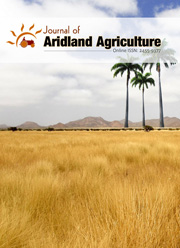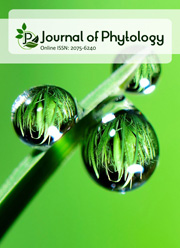Effect of phosphorus fertilization on nodulation, growth, yield and quality of soybean varieties
DOI:
https://doi.org/10.25081/jaa.2023.v9.8364Keywords:
Nodulation, Phosphorus fertilization, Seed quality, Seed yield, SoybeanAbstract
Phosphorus is a very important nutritional element that affects soybean growth and nodule nitrogen fixation. The objective of the study was to assess the effect of phosphorus on the growth, yield and quality of different soybean varieties. In this regard, five different doses of phosphorus viz., control (no phosphorus), 50% of the recommended dose (RD) (18 kg ha-1), 100% of RD (36 kg ha-1), 150% of RD (54 kg ha-1) and 200% of RD (72 kg ha-1) were applied on eight distinct soybean varieties namely Shohag, BARI Soybean-5, BARI Soybean-6, PB-1, Binasoybean-1, Binasoybean-2, Binasoybean-3 and Binasoybean-4. The experiment was set up using a randomized complete block design with three replications, Soybean varieties showed variability in terms of plant stature, number of branches plant-1 and number of nodules plant-1. Application of 100% of RD of phosphorus gave maximum plant height, number of branches plant-1 and nodules plant-1 at 45, 60 and 75 DATs. In the case of variety, Binasoybean-1 showed the maximum number of pods plant-1, 100-seed weight, and seed yield. Application of 100% RD of phosphorus exhibited maximum number of branches plant-1, pod length, pods plant-1, seeds pod-1, seed yield, protein and oil contents. Considering the interaction effect, Binasoybean-1 responded well to the application of 100% of RD of phosphorus and gave the maximum seed yield with the highest protein content. Finally, it may be concluded that Binasoybean-1 with the application of 100% RD of phosphorus would be recommended to get desirable yield and quality of soybean.
Downloads
References
Aise, D., Erdal, S., Hasan, A., & Ahment, M. (2011). Effects of different water, phosphorus and magnesium doses on the quality and yield factors of soybean (Glycine max L.) in Harran plain conditions. International Journal of Physical Sciences, 6(7), 1484-1495.
Araújo, A. P., Plassard, C., & Drevon, J. J. (2008). Phosphatase and phytase activities in nodules of common bean genotypes at different levels of phosphorus supply. Plant and Soil, 312, 129-138. https://doi.org/10.1007/s11104-008-9595-3
Barman, D. K., Sarkar, S. K., Salam, M. A., & Paul, S. K. (2023). Response of Yield and Quality of Soybean (cv. BARI Soybean-6) to Phosphorus and Sulphur Fertilization under Old Brahmaputra Floodplain Soil of Bangladesh. Agricultural Science Digest, 43(3), 301-305. https://doi.org/10.18805/ag.DF-408
Bethlenfalvay, G. J., Schreiner, R. P., & Mihara, K. L. (1997). Mycorrhizal fungi effects on nutrient composition and yield of soybean seeds. Journal of Plant Nutrition, 20(4-5), 581-591. https://doi.org/10.1080/01904169709365276
Bothe, D. T., Sabale, R. N., & Raundal, P. U. (2000). Effect of phosphorus, plant population and P-Solubilizeron soybean-fenugreek cropping system. Journal of Maharashtra Agricultural Universities, 25(3), 310-311.
Bulgarelli, R. G., De Oliveira, V. H., & de Andrade, S. A. L. (2020). Arbuscular mycorrhizal symbiosis alters the expression of PHT1 phosphate transporters in roots and nodules of P-starved soybean plants. Theoretical and Experimental Plant Physiology, 32, 243-253. https://doi.org/10.1007/s40626-020-00185-8
DAFF. (2010). Soybeans production guideline. Department of Agriculture, Forestry and Fisheries, RSA, DPP.
Das, S., Paul, S. K., Rahman, M. R., Roy, S., Uddin, F. M. J., & Rashid, M. H. (2022). Growth and yield response of soybean to sulphur and boron application. Journal of Bangladesh Agricultural University, 20(1), 12-19.
Dong, Q., Echigo, K., Raboy, V., & Saneoka, H. (2020). Seedling growth, physiological characteristics, nitrogen fixation, and root and nodule phytase and phosphatase activity of a low-phytate soybean line. Plant Physiology and Biochemistry, 149, 225-232. https://doi.org/10.1016/j.plaphy.2020.02.015
FAO. (2021). FAOSTAT Database. Food and Agriculture Organization of the United Nations. Retrieved from www.fao.org/faostat
Folsch, J., Lees, M., & Stanley, G. H. S. (1957). A simple method for the isolation and purification of total lipides from animal tissues. Journal of Biological Chemistry, 226(1), 497-509. https://doi.org/10.1016/S0021-9258(18)64849-5
FRG. (2012). Fertilizer Recommendation Guide. Bangladesh Agricultural Research Council. Farmgate, New Airport Road, Dhaka-1215.
Imran, & Amanullah. (2023). Integration of peach (Prunus persica L) remnants in combination with beneficial microbes and phosphorus differ phosphorus use efficiency, agronomic efficiency and partial factor productivity in soybean Vs maize crops. Journal of Plant Nutrition, 46(8), 1745-1756. https://doi.org/10.1080/01904167.2022.2099890
Jackson, M. L. (1973). Soil Chemical Analysis. (2nd ed.). New Delhi, India: Prentice Hall of India Private Limited.
Jaybhay, S. A., Varghese, P., & Taware, S. P. (2021). Influence of foliar application of nutrient on growth, yield, economics, soil nutritional status and nutrient uptake of soybean. Legume Research, 44(11), 1322-1327. https://doi.org/10.18805/LR-4218
Jones, G. D., Lutz, J. A., & Smith, T. J. (1977). Effects on phosphorus and potassium on soybean nodules and seed yield. Agronomy Journal, 69(6), 1003-1006. https://doi.org/10.2134/agronj1977.00021962006900060024x
Khan, M. S. A., Karim, M. A., Haque, M. M., Karim, A. J. M. S., & Mian, M. A. K. (2015). Growth and dry matter partitioning in selected soybean (Glycine max L.) genotypes. Bangladesh Journal of Agricultural Research, 40(3), 333-345.
Krueger, K., Goggi, A. S., Mallarino, A. P., & Mullen, R. E. (2013). Phosphorus and potassium fertilization effects on soybean seed quality and composition. Crop Science, 53(2), 602-610.
Kumaga, F. K., & Ofori, K. (2004). Response of soybean to Bradirhizobia inoculation and phosphorus application. International Journal of Agriculture and Biology, 6, 324-327.
Kumar, R., & Chandra, R. (2008). Influence of PGPR and PSB on rhizobium Leguminosarum Bv. Viciae competition and symbiotic performance in lentil. World Journal of Agricultural Sciences, 4, 297-301.
Li, H., Wang, X., Liang, Q., Lyu, X., Li, S., Gong, Z., Dong, S., Yan, C., & Ma, C. (2021). Regulation of phosphorus supply on nodulation and nitrogen fixation in soybean plants with dual-root systems. Agronomy, 11(11), 2354. https://doi.org/10.3390/agronomy11112354
Lu, M., Cheng, Z., Zhang, X.-M., Huang, P., Fan, C., Yu, G., Chen, F., Xu, K., Chen, Q., Miao, Y., Han, Y., Feng, X., Liu, L., & Fu, Y.-F. (2020). Spatial divergence of PHR-PHT1 modules maintains phosphors homeostasis in soybean nodules. Plant Physiology, 184(1), 236-250. https://doi.org/10.1104/pp.19.01209
Mabapa, P. M., Ogola, J. B. O., Odhiambo, J. J. O., Whitbread, A., & Hargreaves, J. (2010). Effect of phosphorus fertilizer rates on growth and yield of three soybean (Glycine max) cultivars in Limpopo Province. African Journal of Agricultural Research, 5(19), 2653-2660.
Maurya, B. M., & Rathi, K. S. (2000). Growth and development of soybean as influenced by intercropping with pigeon pea and phosphorus level. Gujarat Agricultural University Research Journal, 26, 1-5.
Miao, S.-J., Qiao, Y.-F., Han, X.-Z., & An, M. (2007). Nodule formation and development in soybeans (Glycine max L.) in response to phosphorus supply in solution culture. Pedosphere, 17(1), 36-43. https://doi.org/10.1016/S1002-0160(07)60005-8
Nimu, S. F., Paul, S. K., Salam, M. A., & Sarkar, S. K. (2020). Influence of weed free periods on the growth, yield and quality of soybean (Glycine max L.). Fundamental and Applied Agriculture, 5(1), 99-107. https://doi.org/10.5455/faa.80967
Okazaki, S., Kaneko, T., Sato, S., & Saeki, K. (2013). Hijacking of leguminous nodulation signaling by the Rhizobial type III secretion system. Proceedings of the National Academy of Sciences, 110(42), 17131-17136. https://doi.org/10.1073/pnas.1302360110
Oldroyd, G. E. D., Murray, J. D., Poole, P. S., & Downie, J. A. (2011). The rules of engagement in the legume-rhizobial symbiosis. Annual Reviews of Genetics, 45, 119-144. https://doi.org/10.1146/annurev-genet-110410-132549
Rabbani, M. G., Salam, M. A., Kheya S. A., & Paul. S. K. (2023b). Effect of Bradyrhizobium inoculum and levels of phosphorus on the yield and quality of soybean. Tropical and Subtropical Agroecosystems, 26(3), 105. https://doi.org/10.56369/tsaes.5000
Rabbani, M. G., Salam, M. A., Paul, S. K., & Kheya, S. A. (2023a). Effects of Rhizobium inoculum on growth, yield and quality of eight selected soybean (Glycine Max) Varieties. Journal of the Bangladesh Agricultural University, 21(1), 1-11. https://doi.org/10.5455/JBAU.141905
Radutoiu, S., Madsen, L. H., Madsen, E. B., Jurkiewicz, A., Fukai, E., Quistgaard, E. M. H., Albrektsen, A. S., James, E. K., Thirup, S., & Stougaard, J. (2007). LysM domains mediate lipochitin-oligosaccharide recognition and Nfr genes extend the symbiotic host range. EMBO Journal, 26(17), 3923-3935. https://doi.org/10.1038/sj.emboj.7601826
Rashid, M. H., Akther, S., Paul, S. K., Afroz, N., Jahan, I., & Arafat, Y. (2023). Effect of foliar application of nitrogen and zinc on the performance of soybean. Fundamental and Applied Agriculture, 8(1&2), 490-496. https://doi.org/10.5455/faa.159807
Roux, M. R. L., Khan, S., & Valentine, A. J. (2009). Nitrogen and carbon costs of soybean and lupin root systems during phosphate starvation. Symbiosis, 48, 102-109. https://doi.org/10.1007/BF03179989
Sa, T.-M., & Israel, D. W. (1991). Energy status and functioning of phosphorus-deficient soybean nodules. Plant Physiology, 97(3), 928-935. https://doi.org/10.1104/pp.97.3.928
Sanginga, N., Lyasse, O., & Singh, B. B. (2000). Phosphorus use efficiency and nitrogen balance of cowpea breeding lines in a low P soil of the derived savannah zone in West Africa. Plant and Soil, 220, 119-128. https://doi.org/10.1023/A:1004785720047
Schwember, A. R., Schulze, J., del Pozo, A., & Cabeza, R. A. (2019). Regulation of symbiotic nitrogen fixation in legume root nodules. Plants, 8(9), 333. https://doi.org/10.3390/plants8090333
Taliman, N. A., Dong, Q., Echigo, K., Raboy, V., & Saneoka, H. (2019). Effect of phosphorus fertilization on the growth, photosynthesis, nitrogen fixation, mineral accumulation, seed yield, and seed quality of a soybean low-phytate line. Plants, 8(5), 119. https://doi.org/10.3390/plants8050119
Tang, C., Hinsinger, P., Drevon, J. J., & Jaillard, B. (2001). Phosphorus deficiency impairs early nodule functioning and enhances proton release in roots of Medicago truncatula L. Annals of Botany, 88(1), 131-138. https://doi.org/10.1006/anbo.2001.1440
Usherwood, N. R. (1998). Nutrient management for top-profit soybeans.
Wahhab, D. M., Mondal, M. R. I., Akbar, A. M., Alam, S. M., Ahmed U. M., & Begam F. (2001). Status of oil crop production in Bangladesh. Joydebpur, Gazipur: Oil Seed Research Center, Bangladesh Agricultural Research Institute.
Wirnas, D., Trikoesoemaningtyas, H. S., Sutjahjo, D., Sopandie, W. R., Rohaeni, S., & Marwiyah, S. (2012). Keragaman karakter komponen hasil dan hasil pada genotipe kedelai hitam. Indonesian Journal of Agronomy, 40(3), 184-189.
Xiang, D. B., Yong, T. W., Yang, W. Y., Wan, Y., Gong, W. Z., Cui, L., & Lei, T. (2012). Effect of phosphorus and potassium nutrition on growth and yield of soybean in relay strip intercropping system. Scientific Research and Essay, 7(3), 342-351.
Yasmin, W., Paul, S. K., & Anwar, M. P. (2020). Growth, yield and quality of faba bean (Vicia faba L.) in response to sowing date and phosphorus fertilization. Archives of Agriculture and Environmental Science, 5(1), 11-17. https://doi.org/10.26832/24566632.2020.050102
Yi, X., Bellaloui, N., MaClure, A. M., Tyler, D. D., & Mengistu, A. (2016). Phosphorus fertilization differentially influences fatty acids, protein, and oil in soybean. American Journal of Plant Sciences, 7(14), 1975-1992. https://doi.org/10.4236/ajps.2016.714180
Published
How to Cite
Issue
Section
Copyright (c) 2023 Md. Golam Rabbani, Md. Abdus Salam, Sinthia Afsana Kheya, Swapan Kumar Paul

This work is licensed under a Creative Commons Attribution-NonCommercial 3.0 Unported License.





 .
.